Only one tank on display as Vladimir Putin says country is going through 'difficult period'
Sky News
Updated Thu, May 9, 2024
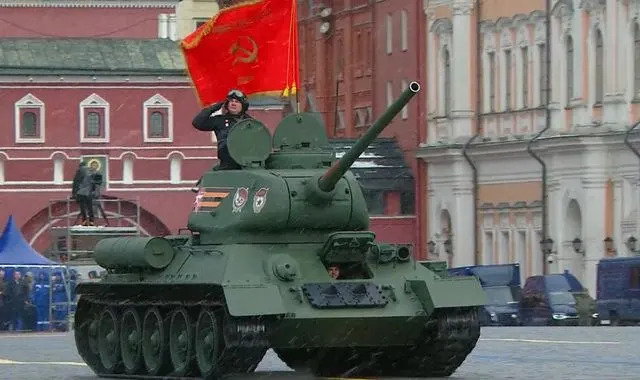
Russia only had one tank on display during its Victory Day parade this year.
Every year, Moscow wraps itself in patriotic pageantry for Victory Day, a celebration of its victory over Nazi Germany in the Second World War.
Today marks the 79th anniversary and Mr Putin addressed the parade in the Red Square, talking up his country's military capabilities in a speech aimed as much at a foreign audience as a domestic one.
Vladimir Putin used his Victory Day speech this year to try and warn Russia's combat forces were "always ready" but admitted the country was going through a "difficult period".
In the parade in Moscow, only one tank was present throughout the entire display - as the country continues to dedicate considerable firepower and resources to its war in Ukraine.
The Second World War T34 tank was the only one present - as it was last year too.
Back in the delayed 2020 parade there were reportedly over 20 tanks present, compared to just one in 2023 and one in 2024.
Other armoured vehicles were pictured as thousands of servicemen marched along the parade.
During this year's speech, Mr Putin admitted that Russia was going through a "difficult period" as the "future of the motherland depends on us".
"Today on Victory Day we are conscious of that even more acutely," he said before warning: "Our strategic forces are always combat ready."
The leader of the Kremlin also said Russia's nuclear forces were always at combat readiness, as he addressed massed ranks of Russian servicemen.
Mr Putin, who this week began his fifth term in office, said Russia would do everything it could to avoid global confrontation, but it would not allow anyone to threaten it.
He also used the speech to send a message to the Russian troops fighting in Ukraine, trying to bolster their morale as the war continues to drag on.
He finished on: "For Russia! For victory! Hurrah!" as thousands of soldiers cheered in return.
Earlier this year, Russia began refitting old tanks after losing 3,000 while fighting in Ukraine, according to a leading research centre.
Moscow lost more than its entire pre-invasion active inventory of tanks in its war with Ukraine, but has enough lower-quality armoured vehicles in storage for years of replacements, the International Institute for Strategic Studies (IISS) said.
But even after such losses, the IISS said Russia still had about twice as many available for combat as Ukraine.
Since coming to power, Mr Putin has made 9 May an important part of his political agenda, featuring displays of military might.
Columns of military vehicles and missiles roll across Red Square every year and squadrons of fighter jets roar overhead as medal-bedecked veterans join him to review the parade.
Many wear the black-and-orange St George's ribbon that is traditionally associated with Victory Day.
Putin’s victory parade a sign of Russia’s ‘degraded’ armoured supplies
James Rothwell
Thu, May 9, 2024
A solitary Soviet tank led Vladimir Putin’s Victory Day celebrations in Moscow as soldiers patrolled with anti-drone guns amid fears of Ukrainian attacks.
The Soviet T-34 was the only Russian tank passing through the streets, marking victory over Nazi Germany 79 years ago, as was the case last year.
Analysts said it was a further sign that Russian armoured supplies have been severely degraded since the start of the war. At least 20 tanks took part in the pre-war 2020 victory parade.
However, the parade featured a number of foreign tanks apparently captured from Ukrainian forces, with some bearing British, American and Czech flags.
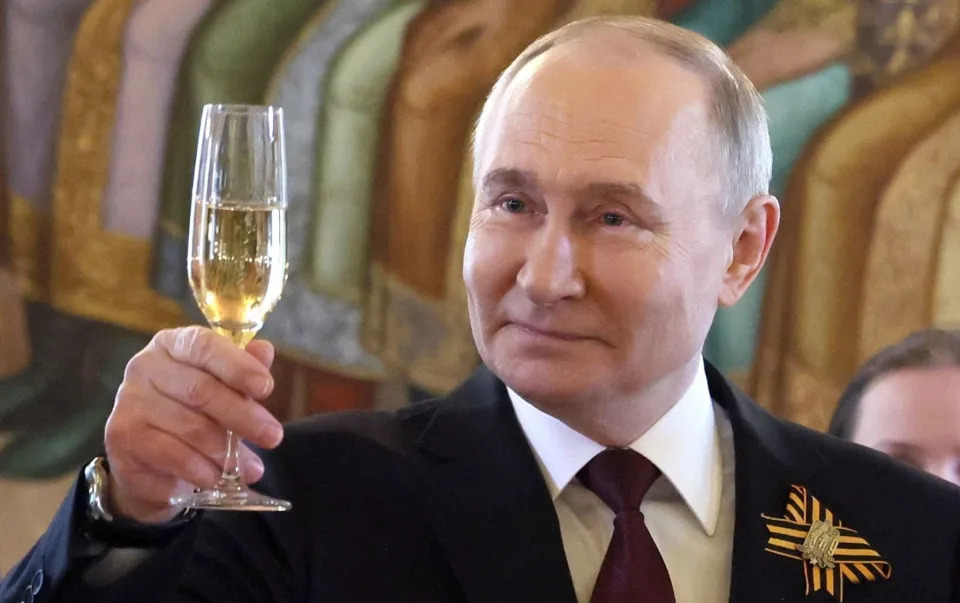
Putin pictured at a reception for heads of state after the Victory Day parade in Moscow - Mikhail Metzel/Shutterstock

The solitary Soviet tank was also a feature of last year's parade - Sefa Karacan/Anadolu
Some soldiers taking part in the parade were carrying devices that appeared to be handheld drone signal jammers, potentially an attempt to ward off any attacks by Ukranian UAVs.
Ukraine’s drone fleet has proven capable of striking targets deep inside Russia, including Moscow itself.
Sitting in the front row along with Putin were a number of his close allies, including Serdar Berdimuhamedov, the president of Turkmenistan and Aleksandr Lukashenko, the president of Belarus. Mr Lukashenko was joined by his white Pomeranian, Umka, named after a Soviet poem.
The leaders of Cuba, Laos and Guinea-Bissau also turned up – but not Nikol Pashinyan, Armenia’s prime minister, who snubbed the event, though he was in Moscow on Wednesday evening for a regional summit.
There was an unseasonable flurry of spring snow during the parade, adding a chilly atmosphere to an event shunned by Western leaders since the February 2022 invasion.
In sub-zero temperatures, a unit of female soldiers were dressed in white skirts, gold belts and black boots. Unusually for military uniforms, they wore their skirts several inches above the knee.
The soldiers gave beaming salutes to the Russian president as they marched through Moscow.
Troops from the Central African Republic, where a large presence of Wagner mercenaries is building up Moscow’s influence, also took part in the parade – the second since Putin launched his full-scale invasion of Ukraine.
The CAR troops wore red berets and white boots, marching past in two six-man columns.
The Wagner group has been expanding its presence across the African continent where it is accused of committing human rights abuses. Its most recent deployments have focused on Mali, Niger and Burkina Faso, three states which have also recently seen military coups.
In a speech to the lines of soldiers and dignitaries, Putin said that the “future of the motherland depends on us2.
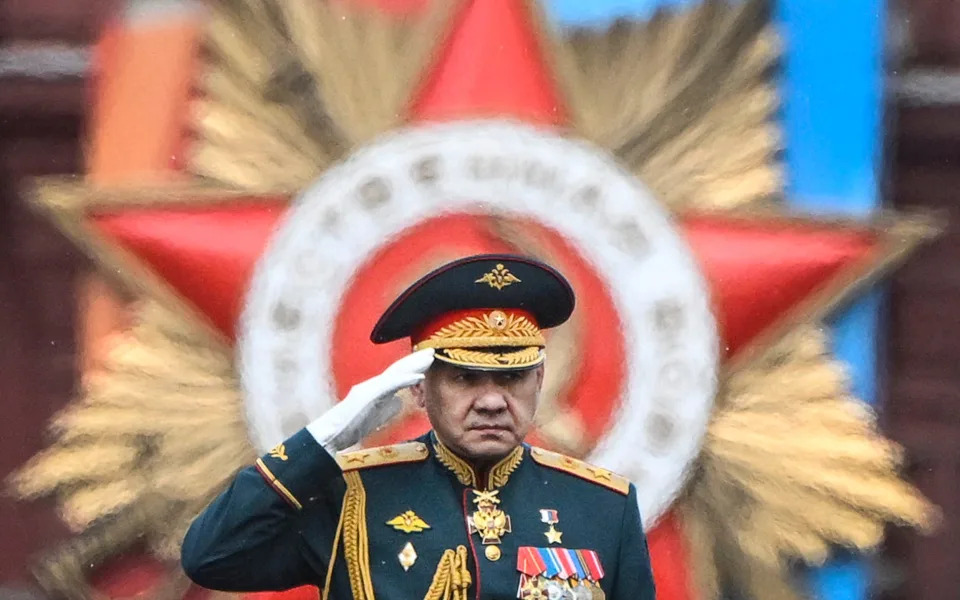
Sergei Shoigu, the Russian defence minister, salutes soliders at the parade - Alexander Nemenov/AFP
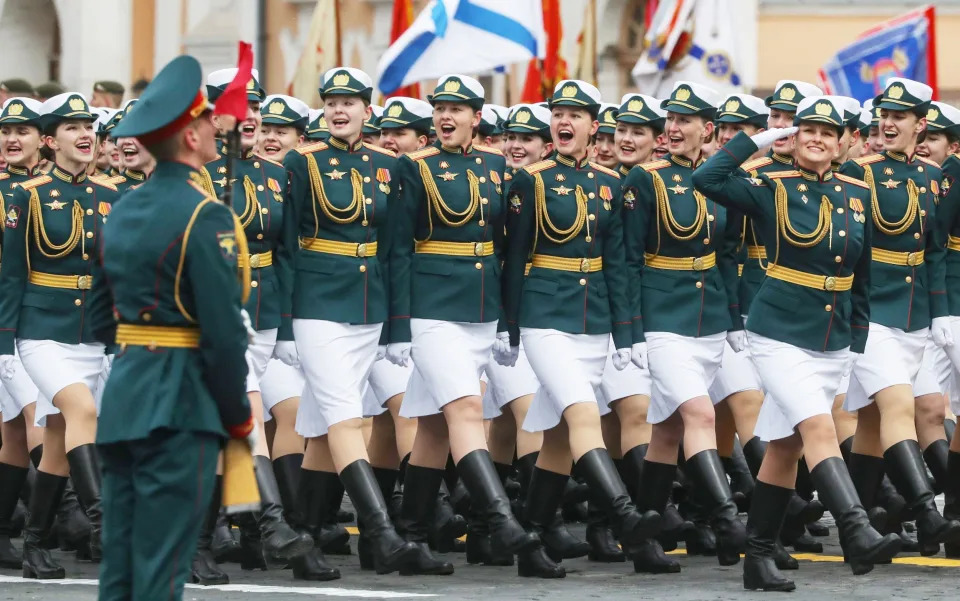
Despite the wintry spring weather in Moscow, this unit wore skirts above the knee - Maxim Shipenkov/Shutterstock
“Today on Victory Day we are conscious of that even more acutely,” he added before making a threat about nuclear weapons.
“Our strategic forces are always combat ready,” he said, referring to Russia’s nuclear capabilities.
The Kremlin is planning to hold weapons tests simulating the deployment of tactical, short-range nuclear weapons in southern Russia and Putin addressed concerns over these tests in comments to state broadcasters after the Victory Day parade.
“There is nothing unusual here, this is planned work,” Putin said. “It is training.”
The Russian president ended his Victory Day speech with the clarion call, “For Russia! For victory! Hurrah”, prompting cheers from thousands of soldiers.
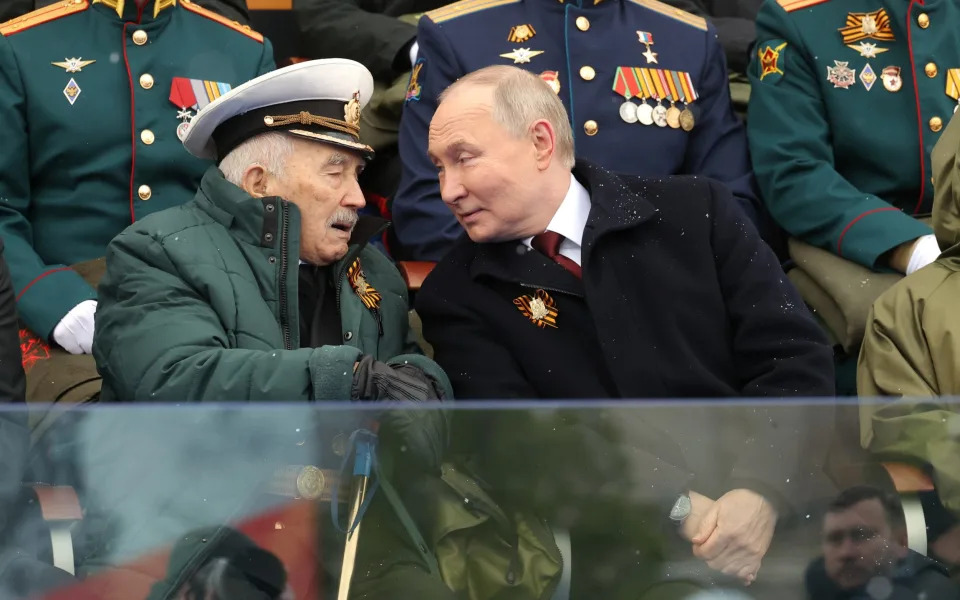
Putin watched the parade sitting with military top brass - Sergei Karpukhin/AFP
Putin included a brief reference to the war in Ukraine, in which he characterised those fighting there as “heroes”, comparing them to World War Two veterans. Around 27 million Soviet soldiers are said to have been killed in World War Two, though experts believe the true figure could be much higher.
Later in his address, Putin said he would not allow “anyone” to threaten Russia, in a clear reference to the West, though he stopped short of the rhetoric of nuclear Armageddon he has used on other occasions since the start of the war.
He said: “Russia will do everything to prevent a global clash. But at the same time we will not allow anyone to threaten us. Our strategic forces are always in a state of combat readiness.”
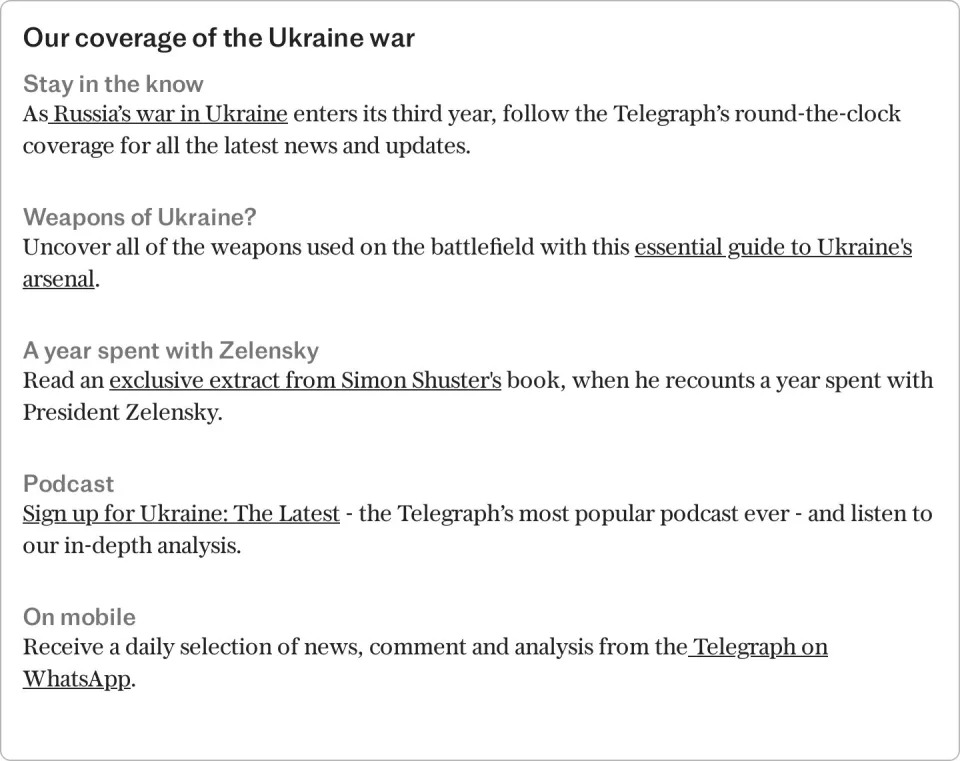
OUR UKRAINE/RUSSIA WAR COVERAGE
Associated Press
Updated Thu, May 9, 2024
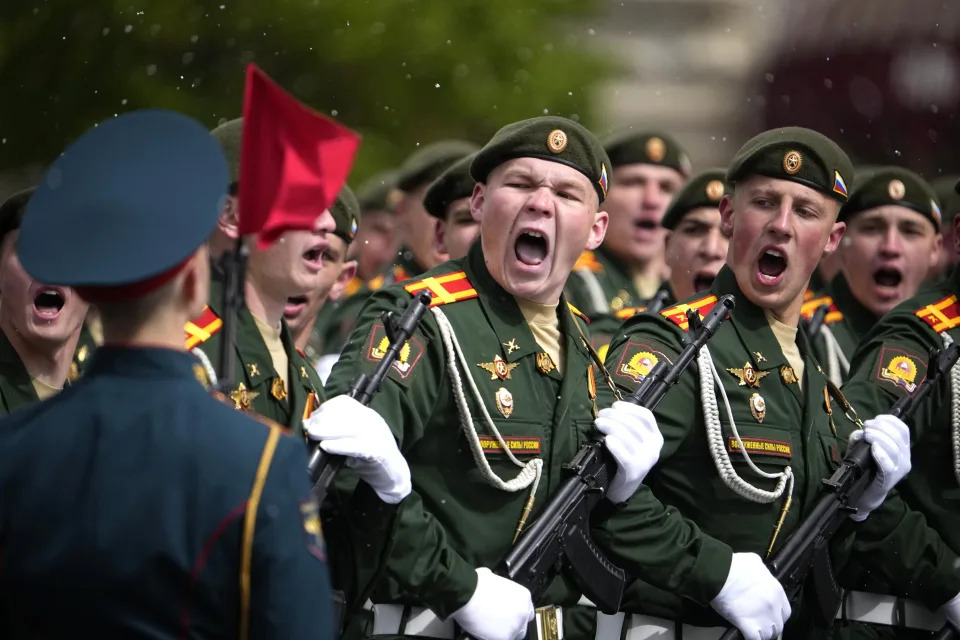

1 / 23
APTOPIX Russia Victory Day Parade
Russian servicemen march during the Victory Day military parade in Moscow, Russia, Thursday, May 9, 2024, marking the 79th anniversary of the end of World War II. (AP Photo/Alexander Zemlianichenko)
MOSCOW (AP) — Russia on Thursday wrapped itself in patriotic pageantry for Victory Day, as President Vladimir Putin celebrated the defeat of Nazi Germany in World War II by hailing his forces fighting in Ukraine and blasting the West for fueling conflicts around the world.
Even though few veterans of what Russia calls the Great Patriotic War are still alive 79 years after Berlin fell to the Red Army, the victory remains the most important and widely revered symbol of Russia’s prowess and a key element of national identity.
Putin has turned Victory Day — the country's most important secular holiday — into a pillar of his nearly quarter-century in power and a justification of his military action in Ukraine.
Two days after beginning his fifth term in office, he led the festivities across Russia that recall the nation's wartime sacrifice.
“Victory Day unites all generations,” Putin said in a speech in Red Square that came on the coldest May 9 in decades amid some snow flurries. “We are going forward relying on our centuries-old traditions and feel confident that together we will ensure a free and secure future of Russia."
As battalions marched by and military hardware — both old and new — rumbled over the cobblestones, the sky cleared briefly to allow a flyby of warplanes, some of which trailed smoke in the white, red and blue of the Russian flag.
Putin hailed the troops fighting in Ukraine as “our heroes” for their courage, resilience and self-denial, adding that “all of Russia is with you.”
He accused the West of “fueling regional conflicts, inter-ethnic and inter-religious strife and trying to contain sovereign and independent centers of global development.”
With tensions with Washington over Ukraine soaring to their highest level since the Cold War, Putin issued another stark reminder of Moscow's nuclear might.
“Russia will do everything to prevent global confrontation, but will not allow anyone to threaten us,” he said. “Our strategic forces are in combat readiness.”
Nuclear-capable Yars intercontinental ballistic missiles were pulled across Red Square, underscoring his message.
The Soviet Union lost about 27 million people in World War II, an estimate that many historians consider conservative, scarring virtually every family.
Nazi troops overran much of the western Soviet Union when they invaded in June 1941, before being driven back all the way to Berlin, where the USSR's hammer and sickle flag was raised above the ruined capital. The U.S., U.K, France and other allies mark the end of the war in Europe on May 8.
The immense suffering and sacrifice in cities like Stalingrad, Kursk and Putin's native Leningrad — now St. Petersburg — still serve as a powerful symbol of the country's ability to prevail against seemingly overwhelming challenges.
Since coming to power on the last day of 1999, Putin has made May 9 an important part of his political agenda, featuring missiles, tanks and fighter jets. Medal-bedecked veterans joined him Thursday to review the parade, and many — including the president — wore the black-and-orange St. George’s ribbon that is traditionally associated with Victory Day.
About 9,000 troops, including about 1,000 who fought in Ukraine, took part in Thursday's parade.
Although the U.S. and U.K. ambassadors did not attend, Putin was joined by other dignitaries and presidents of several former Soviet nations along with a few other Moscow allies, including the leaders of Cuba, Guinea-Bissau and Laos.
In his speech, he accused the West of “revanchism … hypocrisy and lies” in seeking to play down the Soviet role in defeating Nazi Germany.
Putin described Victory Day as “very emotional and poignant.”
“Every family is honoring its heroes, looking at pictures with dear faces and remembering their relatives and how they fought,” he said.
Putin, 71, talks frequently about his family history, sharing memories of his father, who fought on the front during the Nazi siege of the city and was badly wounded.
As Putin tells it, his father, also named Vladimir, came home from a military hospital during the war to see workers trying to take away his wife, Maria, who had been declared dead of starvation. But the elder Putin did not believe she had died — saying she had only lost consciousness, weak with hunger. Their first child, Viktor, died during the siege when he was 3, one of more than 1 million Leningrad residents who died in the 872-day blockade, most of them from starvation.
For several years, Putin carried a photo of his father in Victory Day marches — as did others honoring relatives who were war veterans — in what was called the “Immortal Regiment.”
Those demonstrations were suspended during the coronavirus pandemic and then again amid security concerns after the start of the fighting in Ukraine.
As part of his efforts to burnish the Soviet legacy and trample on any attempts to question it, Russia has introduced laws that criminalized the “rehabilitation of Nazism” that include punishing the “desecration” of memorials or challenging Kremlin versions of World War II history.
When he sent troops into Ukraine on Feb. 24, 2022, Putin evoked World War II in seeking to justify his actions that Kyiv and its Western allies denounced as an unprovoked war of aggression. Putin cited the “denazification” of Ukraine as a main goal of Moscow, falsely describing the government of Ukrainian President Volodymyr Zelenskyy, who is Jewish and lost relatives in the Holocaust, as neo-Nazis.
Putin tried to cast Ukraine’s veneration of some of its nationalist leaders who cooperated with the Nazis in World War II as a sign of Kyiv’s purported Nazi sympathies. He regularly made unfounded references to Ukrainian nationalist figures such as Stepan Bandera, who was killed by a Soviet spy in Munich in 1959, as an underlying justification for the Russian military action in Ukraine.
Many observers see Putin’s focus on World War II as part of his efforts to revive the USSR’s clout and prestige and his reliance on Soviet practices.
“It’s the continuous self-identification with the USSR as the victor of Nazism and the lack of any other strong legitimacy that forced the Kremlin to declare ‘denazification’ as the goal of the war,” Nikolay Epplee said in a commentary for Carnegie Russia Eurasia Center.
The Russian leadership, he said, has “locked itself up in a worldview limited by the Soviet past.”
Putin warns of global crash at celebration of Russia's WWII Victory Day
France 24 Videos
Thu, May 9, 2024
Russia on Thursday wrapped itself in patriotic pageantry for Victory Day, as President Vladimir Putin celebrated the defeat of Nazi Germany in World War II by hailing his forces fighting in Ukraine and blasting the West for fueling conflicts around the world. Story by Eliza Herbert.
Putin watches Russian military parade featuring a solitary, Soviet-era tank
Andrew Roth
Thu, May 9, 2024
A solitary, symbolic tank has featured in Russia’s annual 9 May military parade for the second year in a row as the country was forced to pare down its normal display of military might during a full-scale war in which it has suffered unprecedented losses over the last two years.
The single tank to roll across Red Square as Vladimir Putin reviewed about 9,000 troops was a second world war-era T-34 carrying the banner that the Soviet Union used when it defeated Nazi Germany alongside other allies. The tank has gained iconic status, but is not in combat use and is instead a token of those that used to be part of the 9 May Victory Day celebrations.
It is just one way in which the largest land war in Europe since the second world war has affected Russia’s main military and political celebration. Photographs from Red Square also showed patrolmen carrying anti-drone rifles to guard against sabotage attacks that have become a concern due to the proliferation of drones on the battlefield – and increasingly at military and energy sites inside Russia.
During a separate meeting with Russian commanders fighting in Ukraine, Putin was asked about the possibility of expediting the construction of advanced drones like those used by Ukraine.
“We know how difficult it is for our fighters who are faced with the fact that enemy drones are flying overhead like flies – all this is known,” Putin told the commander. “We are working on this, and I am sure there will be a result.
Oryx, the open-source intelligence defence analysis website, estimates the Russian army has lost at least 3,000 tanks in the last two years, including 2,000 destroyed and another 514 captured by Ukraine. Those are of an estimated 15,724 lost armoured vehicles, including 11,202 that have been destroyed. The actual number is thought to be even higher.
Russia’s parade included several dozens of vehicles including BTR-82A armoured personnel carriers, several types of armoured vehicles, an armoured ambulance and the Yars mobile strategic missile systems, which can carry intercontinental ballistic missiles armed with nuclear warheads.
Putin announced on Thursday that the Russian and Belarusian defence ministries had begun preparations for joint drills on the use of non-strategic nuclear weapons. The Kremlin has called it a response to threats by the west, including Emmanuel Macron’s refusal to rule out sending French troops to fight in Ukraine.
Putin issued a familiar threat: “Russia will do everything to prevent a global clash, but at the same time we will not allow anyone to threaten us,” he said. “Our strategic [nuclear] forces are always on alert.”
Sky News
Updated Thu, May 9, 2024

Russia only had one tank on display during its Victory Day parade this year.
Every year, Moscow wraps itself in patriotic pageantry for Victory Day, a celebration of its victory over Nazi Germany in the Second World War.
Today marks the 79th anniversary and Mr Putin addressed the parade in the Red Square, talking up his country's military capabilities in a speech aimed as much at a foreign audience as a domestic one.
Vladimir Putin used his Victory Day speech this year to try and warn Russia's combat forces were "always ready" but admitted the country was going through a "difficult period".
In the parade in Moscow, only one tank was present throughout the entire display - as the country continues to dedicate considerable firepower and resources to its war in Ukraine.
The Second World War T34 tank was the only one present - as it was last year too.
Back in the delayed 2020 parade there were reportedly over 20 tanks present, compared to just one in 2023 and one in 2024.
Other armoured vehicles were pictured as thousands of servicemen marched along the parade.
During this year's speech, Mr Putin admitted that Russia was going through a "difficult period" as the "future of the motherland depends on us".
"Today on Victory Day we are conscious of that even more acutely," he said before warning: "Our strategic forces are always combat ready."
The leader of the Kremlin also said Russia's nuclear forces were always at combat readiness, as he addressed massed ranks of Russian servicemen.
Mr Putin, who this week began his fifth term in office, said Russia would do everything it could to avoid global confrontation, but it would not allow anyone to threaten it.
He also used the speech to send a message to the Russian troops fighting in Ukraine, trying to bolster their morale as the war continues to drag on.
He finished on: "For Russia! For victory! Hurrah!" as thousands of soldiers cheered in return.
Earlier this year, Russia began refitting old tanks after losing 3,000 while fighting in Ukraine, according to a leading research centre.
Moscow lost more than its entire pre-invasion active inventory of tanks in its war with Ukraine, but has enough lower-quality armoured vehicles in storage for years of replacements, the International Institute for Strategic Studies (IISS) said.
But even after such losses, the IISS said Russia still had about twice as many available for combat as Ukraine.
Since coming to power, Mr Putin has made 9 May an important part of his political agenda, featuring displays of military might.
Columns of military vehicles and missiles roll across Red Square every year and squadrons of fighter jets roar overhead as medal-bedecked veterans join him to review the parade.
Many wear the black-and-orange St George's ribbon that is traditionally associated with Victory Day.
Putin’s victory parade a sign of Russia’s ‘degraded’ armoured supplies
James Rothwell
Thu, May 9, 2024
A solitary Soviet tank led Vladimir Putin’s Victory Day celebrations in Moscow as soldiers patrolled with anti-drone guns amid fears of Ukrainian attacks.
The Soviet T-34 was the only Russian tank passing through the streets, marking victory over Nazi Germany 79 years ago, as was the case last year.
Analysts said it was a further sign that Russian armoured supplies have been severely degraded since the start of the war. At least 20 tanks took part in the pre-war 2020 victory parade.
However, the parade featured a number of foreign tanks apparently captured from Ukrainian forces, with some bearing British, American and Czech flags.

Putin pictured at a reception for heads of state after the Victory Day parade in Moscow - Mikhail Metzel/Shutterstock

The solitary Soviet tank was also a feature of last year's parade - Sefa Karacan/Anadolu
Some soldiers taking part in the parade were carrying devices that appeared to be handheld drone signal jammers, potentially an attempt to ward off any attacks by Ukranian UAVs.
Ukraine’s drone fleet has proven capable of striking targets deep inside Russia, including Moscow itself.
Sitting in the front row along with Putin were a number of his close allies, including Serdar Berdimuhamedov, the president of Turkmenistan and Aleksandr Lukashenko, the president of Belarus. Mr Lukashenko was joined by his white Pomeranian, Umka, named after a Soviet poem.
The leaders of Cuba, Laos and Guinea-Bissau also turned up – but not Nikol Pashinyan, Armenia’s prime minister, who snubbed the event, though he was in Moscow on Wednesday evening for a regional summit.
There was an unseasonable flurry of spring snow during the parade, adding a chilly atmosphere to an event shunned by Western leaders since the February 2022 invasion.
In sub-zero temperatures, a unit of female soldiers were dressed in white skirts, gold belts and black boots. Unusually for military uniforms, they wore their skirts several inches above the knee.
The soldiers gave beaming salutes to the Russian president as they marched through Moscow.
Troops from the Central African Republic, where a large presence of Wagner mercenaries is building up Moscow’s influence, also took part in the parade – the second since Putin launched his full-scale invasion of Ukraine.
The CAR troops wore red berets and white boots, marching past in two six-man columns.
The Wagner group has been expanding its presence across the African continent where it is accused of committing human rights abuses. Its most recent deployments have focused on Mali, Niger and Burkina Faso, three states which have also recently seen military coups.
In a speech to the lines of soldiers and dignitaries, Putin said that the “future of the motherland depends on us2.

Sergei Shoigu, the Russian defence minister, salutes soliders at the parade - Alexander Nemenov/AFP

Despite the wintry spring weather in Moscow, this unit wore skirts above the knee - Maxim Shipenkov/Shutterstock
“Today on Victory Day we are conscious of that even more acutely,” he added before making a threat about nuclear weapons.
“Our strategic forces are always combat ready,” he said, referring to Russia’s nuclear capabilities.
The Kremlin is planning to hold weapons tests simulating the deployment of tactical, short-range nuclear weapons in southern Russia and Putin addressed concerns over these tests in comments to state broadcasters after the Victory Day parade.
“There is nothing unusual here, this is planned work,” Putin said. “It is training.”
The Russian president ended his Victory Day speech with the clarion call, “For Russia! For victory! Hurrah”, prompting cheers from thousands of soldiers.

Putin watched the parade sitting with military top brass - Sergei Karpukhin/AFP
Putin included a brief reference to the war in Ukraine, in which he characterised those fighting there as “heroes”, comparing them to World War Two veterans. Around 27 million Soviet soldiers are said to have been killed in World War Two, though experts believe the true figure could be much higher.
Later in his address, Putin said he would not allow “anyone” to threaten Russia, in a clear reference to the West, though he stopped short of the rhetoric of nuclear Armageddon he has used on other occasions since the start of the war.
He said: “Russia will do everything to prevent a global clash. But at the same time we will not allow anyone to threaten us. Our strategic forces are always in a state of combat readiness.”

OUR UKRAINE/RUSSIA WAR COVERAGE
Russia celebrates victory in World War II as Putin accuses the West of fueling global conflicts
PHOTO ESSAY
Associated Press
Updated Thu, May 9, 2024


1 / 23
APTOPIX Russia Victory Day Parade
Russian servicemen march during the Victory Day military parade in Moscow, Russia, Thursday, May 9, 2024, marking the 79th anniversary of the end of World War II. (AP Photo/Alexander Zemlianichenko)
MOSCOW (AP) — Russia on Thursday wrapped itself in patriotic pageantry for Victory Day, as President Vladimir Putin celebrated the defeat of Nazi Germany in World War II by hailing his forces fighting in Ukraine and blasting the West for fueling conflicts around the world.
Even though few veterans of what Russia calls the Great Patriotic War are still alive 79 years after Berlin fell to the Red Army, the victory remains the most important and widely revered symbol of Russia’s prowess and a key element of national identity.
Putin has turned Victory Day — the country's most important secular holiday — into a pillar of his nearly quarter-century in power and a justification of his military action in Ukraine.
Two days after beginning his fifth term in office, he led the festivities across Russia that recall the nation's wartime sacrifice.
“Victory Day unites all generations,” Putin said in a speech in Red Square that came on the coldest May 9 in decades amid some snow flurries. “We are going forward relying on our centuries-old traditions and feel confident that together we will ensure a free and secure future of Russia."
As battalions marched by and military hardware — both old and new — rumbled over the cobblestones, the sky cleared briefly to allow a flyby of warplanes, some of which trailed smoke in the white, red and blue of the Russian flag.
Putin hailed the troops fighting in Ukraine as “our heroes” for their courage, resilience and self-denial, adding that “all of Russia is with you.”
He accused the West of “fueling regional conflicts, inter-ethnic and inter-religious strife and trying to contain sovereign and independent centers of global development.”
With tensions with Washington over Ukraine soaring to their highest level since the Cold War, Putin issued another stark reminder of Moscow's nuclear might.
“Russia will do everything to prevent global confrontation, but will not allow anyone to threaten us,” he said. “Our strategic forces are in combat readiness.”
Nuclear-capable Yars intercontinental ballistic missiles were pulled across Red Square, underscoring his message.
The Soviet Union lost about 27 million people in World War II, an estimate that many historians consider conservative, scarring virtually every family.
Nazi troops overran much of the western Soviet Union when they invaded in June 1941, before being driven back all the way to Berlin, where the USSR's hammer and sickle flag was raised above the ruined capital. The U.S., U.K, France and other allies mark the end of the war in Europe on May 8.
The immense suffering and sacrifice in cities like Stalingrad, Kursk and Putin's native Leningrad — now St. Petersburg — still serve as a powerful symbol of the country's ability to prevail against seemingly overwhelming challenges.
Since coming to power on the last day of 1999, Putin has made May 9 an important part of his political agenda, featuring missiles, tanks and fighter jets. Medal-bedecked veterans joined him Thursday to review the parade, and many — including the president — wore the black-and-orange St. George’s ribbon that is traditionally associated with Victory Day.
About 9,000 troops, including about 1,000 who fought in Ukraine, took part in Thursday's parade.
Although the U.S. and U.K. ambassadors did not attend, Putin was joined by other dignitaries and presidents of several former Soviet nations along with a few other Moscow allies, including the leaders of Cuba, Guinea-Bissau and Laos.
In his speech, he accused the West of “revanchism … hypocrisy and lies” in seeking to play down the Soviet role in defeating Nazi Germany.
Putin described Victory Day as “very emotional and poignant.”
“Every family is honoring its heroes, looking at pictures with dear faces and remembering their relatives and how they fought,” he said.
Putin, 71, talks frequently about his family history, sharing memories of his father, who fought on the front during the Nazi siege of the city and was badly wounded.
As Putin tells it, his father, also named Vladimir, came home from a military hospital during the war to see workers trying to take away his wife, Maria, who had been declared dead of starvation. But the elder Putin did not believe she had died — saying she had only lost consciousness, weak with hunger. Their first child, Viktor, died during the siege when he was 3, one of more than 1 million Leningrad residents who died in the 872-day blockade, most of them from starvation.
For several years, Putin carried a photo of his father in Victory Day marches — as did others honoring relatives who were war veterans — in what was called the “Immortal Regiment.”
Those demonstrations were suspended during the coronavirus pandemic and then again amid security concerns after the start of the fighting in Ukraine.
As part of his efforts to burnish the Soviet legacy and trample on any attempts to question it, Russia has introduced laws that criminalized the “rehabilitation of Nazism” that include punishing the “desecration” of memorials or challenging Kremlin versions of World War II history.
When he sent troops into Ukraine on Feb. 24, 2022, Putin evoked World War II in seeking to justify his actions that Kyiv and its Western allies denounced as an unprovoked war of aggression. Putin cited the “denazification” of Ukraine as a main goal of Moscow, falsely describing the government of Ukrainian President Volodymyr Zelenskyy, who is Jewish and lost relatives in the Holocaust, as neo-Nazis.
Putin tried to cast Ukraine’s veneration of some of its nationalist leaders who cooperated with the Nazis in World War II as a sign of Kyiv’s purported Nazi sympathies. He regularly made unfounded references to Ukrainian nationalist figures such as Stepan Bandera, who was killed by a Soviet spy in Munich in 1959, as an underlying justification for the Russian military action in Ukraine.
Many observers see Putin’s focus on World War II as part of his efforts to revive the USSR’s clout and prestige and his reliance on Soviet practices.
“It’s the continuous self-identification with the USSR as the victor of Nazism and the lack of any other strong legitimacy that forced the Kremlin to declare ‘denazification’ as the goal of the war,” Nikolay Epplee said in a commentary for Carnegie Russia Eurasia Center.
The Russian leadership, he said, has “locked itself up in a worldview limited by the Soviet past.”
Putin warns of global crash at celebration of Russia's WWII Victory Day
France 24 Videos
Thu, May 9, 2024
Russia on Thursday wrapped itself in patriotic pageantry for Victory Day, as President Vladimir Putin celebrated the defeat of Nazi Germany in World War II by hailing his forces fighting in Ukraine and blasting the West for fueling conflicts around the world. Story by Eliza Herbert.
Putin watches Russian military parade featuring a solitary, Soviet-era tank
Andrew Roth
Thu, May 9, 2024
A solitary, symbolic tank has featured in Russia’s annual 9 May military parade for the second year in a row as the country was forced to pare down its normal display of military might during a full-scale war in which it has suffered unprecedented losses over the last two years.
The single tank to roll across Red Square as Vladimir Putin reviewed about 9,000 troops was a second world war-era T-34 carrying the banner that the Soviet Union used when it defeated Nazi Germany alongside other allies. The tank has gained iconic status, but is not in combat use and is instead a token of those that used to be part of the 9 May Victory Day celebrations.
It is just one way in which the largest land war in Europe since the second world war has affected Russia’s main military and political celebration. Photographs from Red Square also showed patrolmen carrying anti-drone rifles to guard against sabotage attacks that have become a concern due to the proliferation of drones on the battlefield – and increasingly at military and energy sites inside Russia.
During a separate meeting with Russian commanders fighting in Ukraine, Putin was asked about the possibility of expediting the construction of advanced drones like those used by Ukraine.
“We know how difficult it is for our fighters who are faced with the fact that enemy drones are flying overhead like flies – all this is known,” Putin told the commander. “We are working on this, and I am sure there will be a result.
Oryx, the open-source intelligence defence analysis website, estimates the Russian army has lost at least 3,000 tanks in the last two years, including 2,000 destroyed and another 514 captured by Ukraine. Those are of an estimated 15,724 lost armoured vehicles, including 11,202 that have been destroyed. The actual number is thought to be even higher.
Russia’s parade included several dozens of vehicles including BTR-82A armoured personnel carriers, several types of armoured vehicles, an armoured ambulance and the Yars mobile strategic missile systems, which can carry intercontinental ballistic missiles armed with nuclear warheads.
Putin announced on Thursday that the Russian and Belarusian defence ministries had begun preparations for joint drills on the use of non-strategic nuclear weapons. The Kremlin has called it a response to threats by the west, including Emmanuel Macron’s refusal to rule out sending French troops to fight in Ukraine.
Putin issued a familiar threat: “Russia will do everything to prevent a global clash, but at the same time we will not allow anyone to threaten us,” he said. “Our strategic [nuclear] forces are always on alert.”
No comments:
Post a Comment